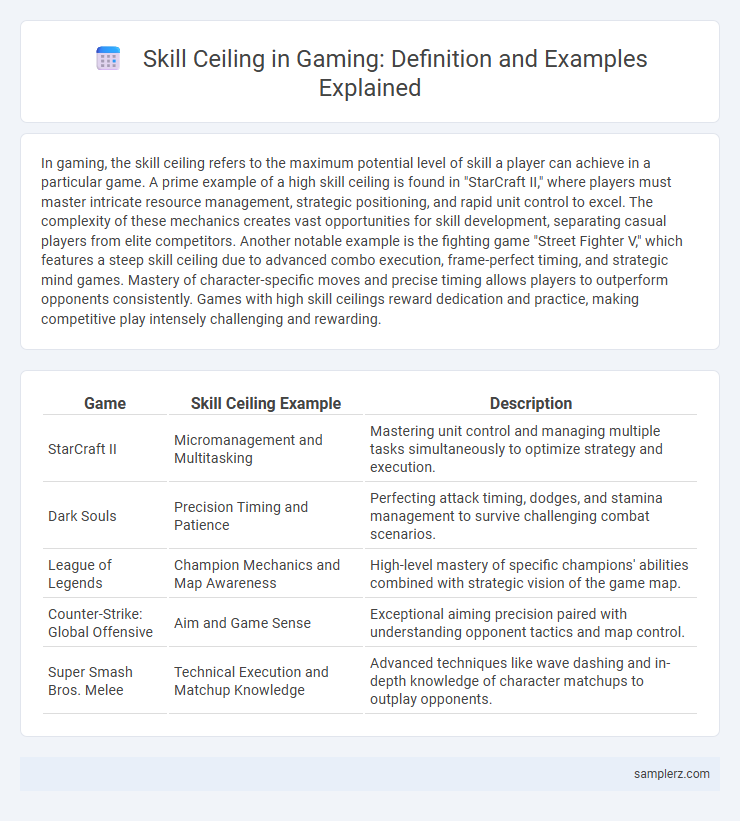In gaming, the skill ceiling refers to the maximum potential level of skill a player can achieve in a particular game. A prime example of a high skill ceiling is found in "StarCraft II," where players must master intricate resource management, strategic positioning, and rapid unit control to excel. The complexity of these mechanics creates vast opportunities for skill development, separating casual players from elite competitors. Another notable example is the fighting game "Street Fighter V," which features a steep skill ceiling due to advanced combo execution, frame-perfect timing, and strategic mind games. Mastery of character-specific moves and precise timing allows players to outperform opponents consistently. Games with high skill ceilings reward dedication and practice, making competitive play intensely challenging and rewarding.
Table of Comparison
| Game | Skill Ceiling Example | Description |
|---|---|---|
| StarCraft II | Micromanagement and Multitasking | Mastering unit control and managing multiple tasks simultaneously to optimize strategy and execution. |
| Dark Souls | Precision Timing and Patience | Perfecting attack timing, dodges, and stamina management to survive challenging combat scenarios. |
| League of Legends | Champion Mechanics and Map Awareness | High-level mastery of specific champions' abilities combined with strategic vision of the game map. |
| Counter-Strike: Global Offensive | Aim and Game Sense | Exceptional aiming precision paired with understanding opponent tactics and map control. |
| Super Smash Bros. Melee | Technical Execution and Matchup Knowledge | Advanced techniques like wave dashing and in-depth knowledge of character matchups to outplay opponents. |
Introduction to Skill Ceiling in Gaming
Skill ceiling in gaming refers to the maximum level of skill or mastery a player can achieve in a particular game, often determined by the game's mechanics and complexity. Games like "StarCraft II" and "Super Smash Bros. Melee" exemplify high skill ceilings, requiring precise execution, deep strategic thinking, and extensive practice. Understanding skill ceilings helps players recognize the potential for growth and the competitive depth within gaming communities.
Defining Skill Ceiling: What Does It Mean?
Skill ceiling in gaming refers to the highest level of difficulty or mastery a player can achieve within a game, representing the extent of skill, strategy, and precision required to excel. Games like "StarCraft II" and "Dark Souls" showcase high skill ceilings, demanding advanced mechanics, deep strategic understanding, and precise execution from players. Understanding the skill ceiling helps gamers measure their progress and identify areas for improvement in complex gameplay environments.
Classic FPS Titles: Mastering Aim and Movement
Classic FPS titles like Counter-Strike and Quake exhibit high skill ceilings through precision aiming and advanced movement techniques such as strafe-jumping and rocket jumping. Mastering these mechanics demands extensive practice, quick reflexes, and deep game sense, distinguishing novice players from experts. These skills significantly impact gameplay effectiveness and competitive success within the genre.
Fighting Games: Advanced Combos and Frame Data
Fighting games exhibit a high skill ceiling through the mastery of advanced combos and frame data analysis, where players optimize attack sequences to maximize damage while minimizing vulnerability. Understanding frame data--detailed information on the startup, active, and recovery frames of moves--allows competitors to time counters and execute frame traps with precision. This deep technical knowledge separates casual players from experts, making skill expression highly nuanced in tournaments such as Street Fighter and Tekken.
Real-Time Strategy: Micro vs. Macro Management
Real-Time Strategy games exemplify skill ceiling through the complex balance of micro and macro management, where players must optimize unit control while simultaneously managing resource allocation and base expansion. Mastery in micro involves precise unit maneuvering and tactical engagements, whereas macro demands strategic oversight of economy, production, and map control. High-level play requires seamless integration of both skills, reflecting the deep strategic complexity and skill differentiation in RTS gaming.
MOBAs: Champion Mastery and Game Sense
In MOBAs like League of Legends, skill ceiling is exemplified by Champion Mastery and Game Sense, where high-level players optimize champion mechanics and understand intricate game dynamics such as map control and objective prioritization. Mastery involves precise execution of combos, timing, and positioning, while advanced Game Sense requires predicting enemy movements and adapting strategies dynamically. These elements collectively define the upper limits of player skill, distinguishing novices from professionals.
Speedrunning: Precision and Consistency
Speedrunning exemplifies a high skill ceiling by demanding exceptional precision and consistency to optimize completion times. Players must execute frame-perfect inputs and memorize intricate sequences to minimize errors and improve their rankings. Mastery in speedrunning requires relentless practice and deep understanding of game mechanics to achieve record-breaking performances.
Platformers: High-Difficulty Level Design
Platformers like "Celeste" and "Super Meat Boy" exemplify a high skill ceiling through intricate level design that demands precise timing, reflexes, and memorization. These games challenge players with complex obstacle layouts and rapid input sequences that significantly increase difficulty as players progress. Mastery in such platformers requires not only mechanical skill but also strategic planning and adaptability to overcome increasingly punishing stages.
Rhythm Games: Timing and Multi-Input Complexity
Rhythm games like "Osu!" and "Dance Dance Revolution" showcase skill ceilings through precise timing demands and complex multi-input sequences. Players must master synchronization with music beats while executing simultaneous inputs, pushing both reaction speed and coordination to advanced levels. High-level performance reflects refined motor skills, pattern recognition, and split-second decision-making essential for competitive play.
Evolving Skill Ceilings: Updates and Metagame Changes
Games like "League of Legends" showcase evolving skill ceilings as frequent patches, champion reworks, and shifting metagames demand continuous adaptation from players. Mastery requires not only mechanical precision but also strategic understanding of newly introduced mechanics and meta shifts. These constant updates elevate the skill ceiling by rewarding players who innovate and optimize strategies in response to game balance changes.

example of skill ceiling in gaming Infographic
 samplerz.com
samplerz.com